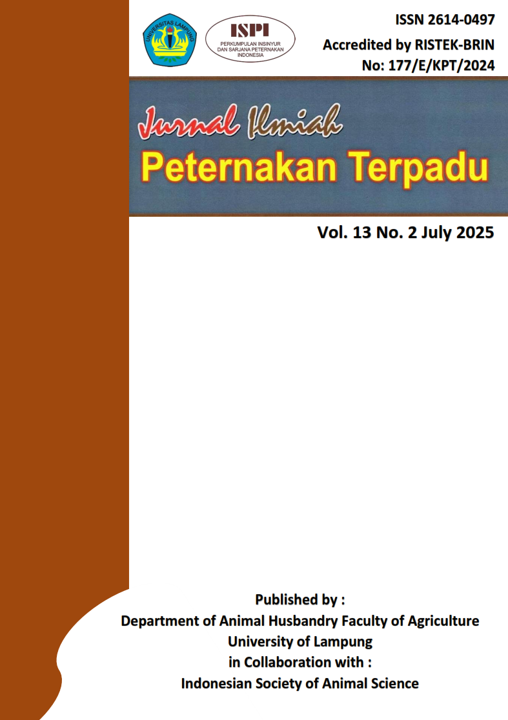Evaluation of Cow Milk Quality with Lactoscan Technology, Alcohol Test, and Reductase at the Batu Livestock Training Center (BBPP)
DOI:
https://doi.org/10.23960/jipt.v13i2.p328-339 Abstract View: 690
Abstract View: 690
Abstract
Evaluation of cow's milk quality is very important to ensure safety and nutritional content in accordance with standards. This research was conducted at the Batu Livestock Training Center (BBPP) using three main testing methods, namely Lactoscan technology, 70% alcohol test, and reductase test. The results showed that the quality of the milk tested was still within acceptable standard limits. The Lactoscan method provided a quick analysis of milk composition, including fat, protein and solid non-fat (SNF) content. The 70% alcohol test indicated good protein stability, while the reductase test indicated acceptable levels of microbial population in the milk but required improved sanitation in the milking and storage processes. This study confirms the importance of implementing hygienic standards in milk production to improve product competitiveness in domestic and international markets.
Downloads
References
Arini, L. D. D., & Ifalahma, D. (2021). Pemeriksaan jumlah total bakteri pada susu sapi segar dari peternakan sapi di daerah Kalijambe Sragen. Journal of Health (JoH), 8(2), 128-139.
Christie, E. N. (2022). Aplikasi susu jali dan fat-replacer terhadap sifat fisikokimia dan sensori produk frozen dessert herbal wedang uwuh. (Doctoral dissertation, Universitas Katolik Soegijapranata Semarang).
Christi, R. F., Salman, L. B., Widjaja, N., & Sudrajat, A. (2022). Tampilan berat jenis, bahan kering tanpa lemak, kadar air, dan titik beku susu sapi perah Friesian Holstein pada pemerahan pagi dan sore di CV Ben Buana Sejahtera Kecamatan Jatinangor Kabupaten Sumedang. Jurnal Sains Peternakan, 10(1), 13-20.
Hidayat, K., & Anggraeni, D. N. (2023, September). Analisis pengendalian mutu bahan baku susu segar pada koperasi peternakan sapi perah XYZ. Prosiding Seminar Nasional Pembangunan dan Pendidikan Vokasi Pertanian, 4(1), 375-387.
Oktafiyanti, K., Anisa, C. D., Zul’adhar, U. R., & Rahmawati, Y. (2024). Efektivitas whey sebagai feed additive pada broiler. Jurnal Triton, 15(1), 1-9.
Pramesti, N. E., & Yudhastuti, R. (2017). Analisis proses distribusi terhadap peningkatan Escherichia coli pada susu segar produksi peternakan X di Surabaya. Jurnal Kesehatan Lingkungan, 9(2), 181-190.
Pratama, T. D. (2023). Peningkatan konsumsi susu sapi untuk anak usia dini sebagai pemenuhan nutrisi di Desa Bedrug. Social Science Academic, 609-622.
Rahmi, D. (2008). Aplikasi Good Manufacturing Practices, Sanitation Standard Operating Procedures dan penentuan titik kendali kritis pada produksi susu pasteurisasi Koperasi Peternak Bandung Selatan. Program Studi Teknologi Hasil Ternak, Institut Pertanian Bogor.
Toni, D. R., & Sirajuddin, M. M. I. (2023). Evaluasi penerapan cara produksi pangan yang baik untuk industri rumah tangga (CPPB-IRT) pada produksi susu pasteurisasi di UMKM X, Magetan. Jurnal Teknologi Pangan dan Industri Perkebunan (LIPIDA), 3(1), 49-60.
Turang, M. W., Yelnetty, A., & M'aruf, W. (2023). Penggunaan bunga telang kering (Clitoria ternatea L.) terhadap nilai pH dan sensoris kefir. ZOOTEC, 43(1), 102-109.
Wiranti, N., Wanniatie, V., Husni, A., & Qisthon, A. (2022). Kualitas susu sapi segar pada pemerahan pagi dan sore. Jurnal Riset dan Inovasi Peternakan (Journal of Research and Innovation of Animals), 6(2), 123-128.
Downloads
Published
How to Cite
Issue
Section
License

Jurnal Ilmiah Peternakan Terpadu(JIPT) is licensed under a Creative Commons Attribution 4.0 International License.
Authors who publish with this journal agree to the following terms:
- Authors retain copyright and grant the journal right of first publication with the work simultaneously licensed under a Creative Commons Attribution License that allows others to share the work with an acknowledgement of the work's authorship and initial publication in this journal.
- Authors are able to enter into separate, additional contractual arrangements for the non-exclusive distribution of the journal's published version of the work (e.g., post it to an institutional repository or publish it in a book), with an acknowledgement of its initial publication in this journal.
- Authors are permitted and encouraged to post their work online (e.g., in institutional repositories or on their website) prior to and during the submission process, as it can lead to productive exchanges, as well as earlier and greater citation of published work (See The Effect of Open Access).





















